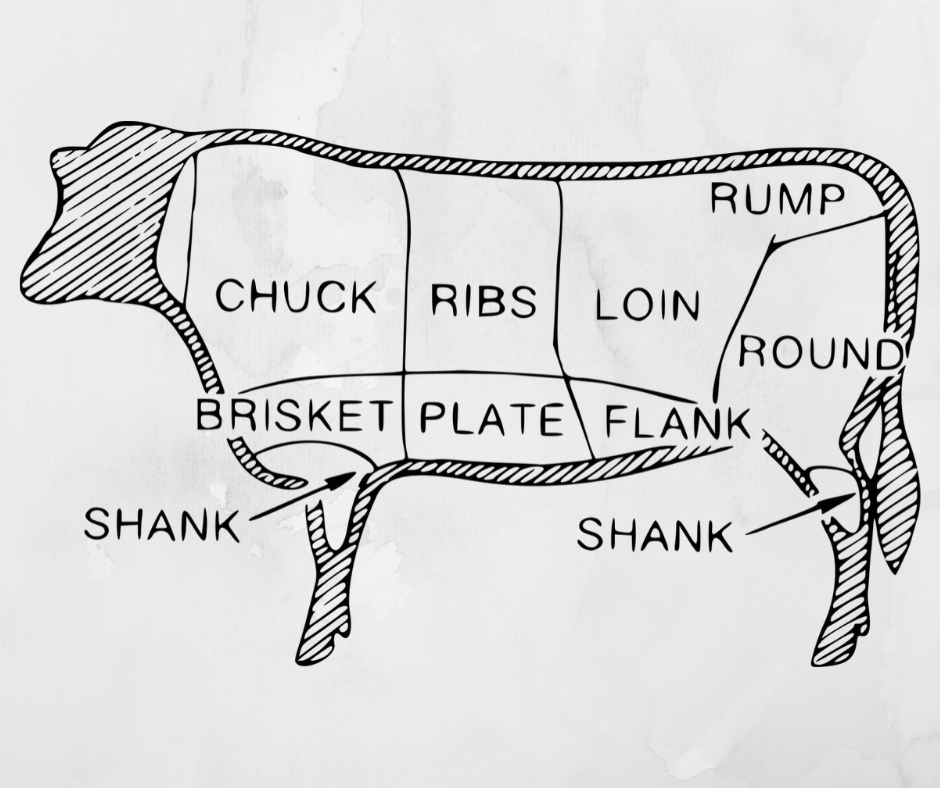
Beef is one of the most popular meats on American dinner tables. Did you know that, on average, Americans each consume over 67 pounds of beef? That’s over one pound of beef every week. As much as most of us enjoy this meat, you may not know what separates one type from another. Butchers separate each part of a steer to create different cuts of beef. While all of these cuts are beef from the same cow, they can differ dramatically.
The muscle usage, marbling, bones and other factors all contribute to a unique flavor and texture profile for each cut of beef. So, how do you keep it all straight when you’re looking to buy something delicious to enjoy for dinner? We’ve created a cuts of beef guide that will provide you with an easy overview of each primal and subprimal cut of beef. We’ll also talk about the best ways to prepare these cuts so you can enjoy naturally tasty beef.
What Are the 8 Primal Cuts of Beef?
Let’s start by looking at the primal cuts of beef. These eight fundamental cuts divide one whole side of beef. First, workers divide this meat into large portions before cutting them into smaller subprimal pieces, which are the individual cuts of meat typically found in butcher shops and supermarkets.
Confidently navigate the kitchen with the help of a comprehensive chart that helps you choose and cook the perfect cut for every meal. A beef cut chart is a visual reference that showcases the different sections of beef, helping you understand the origins of each cut and how to best prepare them for a delicious dining experience. Whether you’re seeking tender steaks or flavorful roasts, exploring cow meat cuts through a cut chart can greatly enhance your cooking expertise. These eight different cuts of meat include the following.
- Chuck: Beef chuck comes from the forequarter of a cow. Chuck consists of the upper arm through the shoulder blade up to part of the neck.
- Rib: The rib cut consists of the sixth through the 12th ribs, not including the lower portion, known as the plate.
- Loin: On the top of the cow, just behind the rib, is the loin. The loin is where the highest-quality cuts of beef come from.
- Round: The rump is at the hind legs and the round is at the cow’s back.
- Flank: The flank is a boneless cut of meat located below the loin.
- Plate: The plate, also called the short plate, is below the rib cut, in the forequarter of the cow.
- Brisket: In the front of the cow, below the chuck, is the brisket cut. This cut is from the cow’s breastbone area.
- Shank: The shank is the upper part of the cow’s legs. Each side of beef includes two shanks — one in the forequarter and one in the back.
What Are the Subprimal Cuts of Beef?
If you’ve purchased beef from a butcher or supermarket, you know beef comes in far more than just eight different cuts. That’s because butchers can further divide each primal cut of beef into smaller sections known as subprimal cuts. Often, you can find subprimal cuts cut down even further into individual cuts at the grocery store.
Now that we’ve looked at the eight primal cuts of beef, let’s turn our attention to the subprimal cuts that belong to each primal cut and how to prepare them to bring out their best textures and flavors.
1. Chuck Subprimal Cuts
Because it includes a lot of connective tissue, the chuck primal cut is relatively tough. Chuck is also high in fat content, which contributes to a rich flavor. Chuck often gets turned into ground beef and it is also a great cut for stews and roasts, since you can slow-cook them to make them tenderer. Let’s take a closer look at the subprimal cuts of beef chuck.
- Chuck tender: Chuck tender is a lean cut divided further into chuck tender steak and chuck tender roast. Marinade to tenderize your chuck tender steak before grilling.
- Chuck roll: Chuck roll is more tender. It consists of two cuts — chuck eye roll and under blade — which produce a range of flavorful roasts, country-style ribs, steaks and more.
- Shoulder clod: The shoulder clod includes the shoulder clod arm roast and shoulder petite tender, which are lean and the more marbled top blade. In addition to slow-cooking, you can grill, broil or smoke the shoulder petite tender.
- Square-cut chuck: This cut is flavorful and tender due to marbling. It consists of many varieties of steaks and roasts, along with pectoral meat and short ribs. You can grill or broil some cuts instead of putting them in a slow cooker.

2. Rib Subprimal Cuts
All-time favorites like the ribeye steak and prime rib roast come from the rib cut. There are only two subprimal cuts, but both include many popular cuts of beef. Because the beef rib section is tender and flavorful, you can cook these versatile cuts to perfection in many different ways.
- Ribeye roll: The ribeye roll includes ribeye steaks and roasts, all of which are rich, juicy and tender. Two of the most delicious ways to cook a ribeye roast are roasting and baking. There are many different methods for preparing steaks, such as grilling, pan-broiling and smoking. Ribeye steaks and roasts are a favorite cut of meat for their delicious flavor and succulent texture.
- Rib subprimal: This subprimal cut includes back ribs, short ribs and rib oven, all of which are tender and delicious. As the name suggests, rib oven is best roasted, while there are various ways to prepare back ribs and short ribs. This subprimal also includes rib fingers and blade/lifter meat.
3. Loin Subprimal Cuts
 The luscious cuts of beef found in the loin come from three distinct parts of the primal cut, making them some of the most sought-after and succulent. Cuts from the loin area of the steer are a popular choice for steak lovers. These include options like the tenderloin and porterhouse steaks, known for their tenderness. Though these cuts are lean, they remain succulent due to their position on the animal.
The luscious cuts of beef found in the loin come from three distinct parts of the primal cut, making them some of the most sought-after and succulent. Cuts from the loin area of the steer are a popular choice for steak lovers. These include options like the tenderloin and porterhouse steaks, known for their tenderness. Though these cuts are lean, they remain succulent due to their position on the animal.
You should bake or roast butts and roasts, and brown tips in a skillet. You can prepare the other loin cuts in various ways according to your preference. Grilling and pan-searing are popular methods for bringing out the delicious flavors in steaks that come from loin subprimal cuts.
- Tenderloin: The tenderloin is a long, narrow section of meat known for being the tenderest of all. The famous filet mignon comes from this subprimal cut, as well as tenderloin roast, tips, tails and butt.
- Strip loin: The strip loin is a boneless cut of meat with generous marbling and delicious flavor. You can prepare it whole as a roast, or subdivide into strip filet, strip petite roast, strip roast and strip steak.
- Short loin: The short loin is another popular subprimal cut for steak lovers. It produces the porterhouse steak and T-bone steak, along with the loin steak tail. These cuts offer bold flavor.
4. Round Subprimal Cuts
The round primal cut is relatively inexpensive and can be a bit tough. Most cuts from the beef round section are lean and have a lower fat content. This cut produces subprimal cuts that are usable and delicious for all sorts of dishes. They may require some marinating or slow-cooking to become tender. Marinating is the method of choice in most cases for steak, and slow-cooking is the best way to tenderize roasts.
- Bottom round: Bottom round is a lean subprimal cut from the outside of the steer’s rear leg. Bottom round consists of two sections — outside round, cut into roasts and steaks, and outside round, or heel, which you can grind or cut into steaks. These cuts are typically best braised or roasted and sliced. For steak cuts, marinate before cooking.
- Eye of round: Eye of round is exceptionally lean and is similar to a tenderloin, though it is much tougher in comparison. It consists of eye of round roast and eye of round steak. The roast is a popular choice for roast beef sandwiches. You can also bake or braise it and enjoy it as a roast. Marinate eye of round steak, then cook it on a grill or in a skillet.
- Sirloin tip: The sirloin tip, also called knuckle, consists of sirloin roasts and steaks. You can also grind it to create ground beef. Sirloin tip is extremely lean. The best ways to prepare roasts include braising, baking or roasting. You can also braise steaks or marinate them before grilling or broiling.
- Top round: The last subprimal cut from the round primal is top round. Also called inside round, top round is lean and is a popular choice for making sliced roast beef. In addition to roasts, you can also use top round to create inexpensive steaks. These steaks benefit from marinating before cooking.
5. Flank Subrimal Cuts
The beef flank primal cut produces only one subprimal cut — flank steak. Also called London broil, jiffy steak or plank steak, flank steak is lean and flavorful. Flank steak is a good choice for ground beef. You can also broil a flank steak, slice it up and stir-fry it or marinate and grill it.
When grilling flank steak, the secret is to cook it a high temperature over a short period. Be careful not to overcook the flank steak so that it remains moist rather than drying out. Once you’ve cooked the steak, cut it into thin slices, going against the grain.
6. Plate Subprimal Cuts
The plate primal offers five subprimal cuts. Unlike many of the beef cuts we’ve looked at, which are best to prepare through slow-cooking methods, many plate subprimal cuts are well-suited to fast cooking over high heat.
- Hanger steak: The hanger steak is a thick, flavorful cut. It has a coarse texture, but you can tenderize it by removing some connective tissue membrane or marinating the steak. Then, you can grill or broil the hanger steak over high heat.
- Inside skirt steak: The inside skirt steak is especially flavorful, and is a favorite subprimal cut for making fajitas or beef stir-fry. For extra flavor and to tenderize the meat a bit, marinate it before cooking strips of inside skirt steak for a short time over high heat.
- Outside skirt steak: The outside skirt steak sits opposite from inside skirt steak, but this subprimal cut is similar to the inside skirt steak. It’s also excellent for fajitas, so you may see it labeled as fajita meat in some instances.
- Plate short ribs: A short section of ribs in the plate primal is plate short ribs. These ribs taste great braised or grilled. If you’re going to grill them, start with a spice rub to impart more flavor.
- Flanken-style short ribs: Flanken-style short ribs, also sometimes referred to as Korean-style short ribs, get cut across the rib bones rather than between each bone. They are an excellent choice for grilling. Be sure to marinate them first.
7. Brisket Subprimal Cuts
Beef brisket is flavorful, but it can be a bit tough, since it comes from a muscle that cows often use in their daily life. Therefore, slow-cooking is a smart approach with brisket, so it becomes tender as it cooks. Brisket has two subprimal cuts — flat half and point half.
- Brisket flat half: This portion of the brisket comes from the posterior part and is relatively thin, hence the name flat half. You may also hear people call it the “first cut.” In addition to traditional methods of slow-cooking, you can try other techniques, such as pressure cooking, smoking or even sous vide.
- Brisket point half: The point half of the brisket is fattier and is exceptionally flavorful. Still, you want to cook it low and slow in most cases to end up with a tender cut of meat you can cut or shred. This cut is not as well-suited to pressure cooking, but you can braise, roast, bake, smoke or sous-vide.
8. Beef Shank Subprimal Cuts
Last on our list of beef cuts is the shank. The shank primal is a section of the leg, so the cow uses these muscles quite a lot. For this reason, shank meat can be tough by default, but cooking it low and slow can cause it to become very tender.
There is only one subprimal cut of the shank primal to be aware of — shank cross-cut. This lean cut is best known for the Italian dish osso buco, where it is the star of the show. Braising it leads to fork-tender meat.
Cooking Ideas for Types of Meat Cuts
From mastering slow-cooking for tenderness to achieving the perfect sear on the grill, here is a collection of cooking ideas for different meat cuts.
Chuck
Braising is a transformative technique that turns chuck steaks’ tough muscle fibers into tender, flavorful strands. The low, slow cooking process allows collagen to dissolve, resulting in a delicious and satisfying dish.
To braise chuck steaks:
- Season them with salt and pepper, then warm up olive oil in a skillet and sear the steaks until browned on both sides. Set them aside.
- In the same skillet, sauté chopped onion, carrots, celery and minced garlic until softened.
- Deglaze the skillet by adding beef broth and red wine, then simmering the mixture.
- Return the seared steaks to the skillet and season to taste.
- Cover the skillet and transfer it to a preheated oven set at 325 degrees Fahrenheit.
- Allow the steaks to braise for approximately two to three hours until the meat becomes tender and easy to shred.
Osso Buco
The shank’s tough meat benefits from extended cooking in liquid. It’s an ideal choice for soups and stews, as the slow cooking extracts its rich flavor while adding depth to the broth. The shank’s connective tissues break down during long cooking, resulting in a melt-in-your-mouth texture.

To make osso buco:
- Season the beef shanks with salt and pepper. Dredge them in flour, shaking off any excess.
- Heat olive oil in a large skillet and brown the shanks on all sides. Set them aside.
- Sauté chopped onion, carrots, celery and minced garlic until slightly softened.
- Deglaze the skillet with dry white wine, scraping up browned bits.
- Transfer the vegetable mixture to a Dutch oven. Add diced tomatoes, beef broth and dried thyme. Place the browned shanks on top.
- Cover and braise in a preheated oven at 325 degrees Fahrenheit for two to three hours until meat is fork-tender. Garnish with chopped fresh parsley before serving.
Smoked Beef Brisket
Brisket’s popularity in barbecue circles is due to its remarkable transformation when slow-cooked. Smoking or braising makes the tough meat tender and succulent, capturing the smoky flavors or the richness of braising liquids.
For this recipe, you’ll need a beef brisket weighing approximately five to six pounds.
- Season it with a rub made from paprika, brown sugar, chili powder, garlic powder, onion powder, cayenne pepper, salt and black pepper.
- Move the brisket into a preheated smoker set at 225 degrees Fahrenheit, using wood chips for smoking.
- Smoke for about an hour and a half per pound, until the internal temperature reaches around 200 degrees Fahrenheit and the meat is tender. Allow the brisket to rest for 30 minutes before slicing.
Grilled or Smoked Barbecue Ribs
Ribs shine with prolonged, dry-heat cooking methods. Grilling or smoking these cuts slowly renders the tough collagen into gelatin, resulting in a satisfyingly chewy, tender texture. This slow cooking also allows flavors to penetrate deeply into the meat.
- Prepare a barbecue rub using brown sugar, paprika, chili powder, garlic powder, onion powder, cayenne, salt and black pepper. Season the ribs generously with the rub.
- Preheat a grill or smoker to low heat. Place the ribs on the grill grates and cook slowly for several hours, turning occasionally.
- During the last hour of cooking, brush the ribs with your favorite barbecue sauce. The ribs are ready to serve when the meat is tender and has pulled back from the bones.
Braised Short Plate
Braising is the ideal technique for the short plate, transforming the tough muscle fibers into tender, flavorful strands. Low, slow cooking allows the collagen to dissolve, creating a delicious and satisfying dish.
- Season your short plate cuts with salt and pepper.
- Heat a Dutch oven and sear the short plate cuts on all sides until browned. Set them aside.
- Sauté chopped onion, carrots, celery and minced garlic until slightly softened.
- Deglaze the Dutch oven with beef broth and red wine. Add fresh herbs such as thyme and rosemary.
- Return the seared short plate cuts to the Dutch oven. Cover and braise in a preheated oven at 325 degrees Fahrenheit for two to three hours until the meat becomes tender and flavorful.
Braised Flank Steak
Flank cuts, known for their toughness, benefit from slow, moist cooking methods like braising. This approach breks down the dense muscle fibers, resulting in a tender steak that’s perfect for various dishes.
- Season the flank cuts with salt and pepper. Heat a skillet and sear the flank cuts on both sides until
nicely browned. Set them aside. - Sauté chopped onion, carrots, celery and minced garlic until slightly softened.
- Deglaze the skillet with beef broth and red wine. Add diced tomatoes and fresh herbs.
- Return the seared flank cuts to the skillet. Cover and braise on low heat for about two hours until the meat becomes tender. Serve the flank steak slices with the flavorful braising liquid.
Grilled Loin Steak
With their low connective tissue content, loin cuts respond well to dry heat methods like grilling. Quick and high-temperature cooking sears the exterior, locking in juices and flavors while keeping the interior tender.
- Season your loin cuts with salt and pepper, then preheat your grill to medium-high heat.
- Place the loin steaks on the grill grates and cook for a few minutes on each side until they reach your desired level of doneness. The high heat sears the exterior, locking in juices and flavors.
- Remove the steaks from the grill and let them rest before slicing and serving.
Grilled Sirloin Steak
Sirloin’s low toughness makes it an excellent candidate for grilling. The direct heat creates a flavorful crust on the outside while retaining moisture within. Additionally, sirloin adapts well to broiling, sautéing or pan-frying for various preparations.

- Season your sirloin steaks with salt and pepper, then preheat your grill to medium-high heat.
- Place the sirloin steaks on the grill grates and cook for a few minutes on each side until they reach your desired level of doneness.
- Let the steaks rest before slicing and serving.
Braised Round Roast
Round or rump round cuts in the cow’s rear leg are best for braising or roasting with low moisture. These methods soften the tough fibers, resulting in a delicious and tender outcome that is perfect for hearty meals.
You’ll need round cuts or a round roast for braised round roast.
- Season the meat with salt and pepper, then preheat a Dutch oven over medium-high heat.
- Add some oil and sear the round cuts on all sides until browned. Set them aside.
- Sauté chopped onion, carrots, celery and minced garlic until slightly softened.
- Deglaze the Dutch oven with beef broth and red wine, adding resh herbs such as thyme and rosemary.
- Return the seared round cuts to the pot. Cover and braise in a preheated oven at 325 degrees Fahrenheit for several hours until the meat becomes tender.
- Slice and serve the braised round cuts in their cooking liquid.
QUALITY SMOKED MEATS, CHEESES AND MORE FROM S. CLYDE WEAVER
At S. Clyde Weaver, we understand meat. For over 100 years, we’ve been smoking, aging and otherwise preparing delicious meats and cheeses that bring Lancaster County’s culinary heritage to your table. Even though we don’t carry fresh beef online or in our store, we create delicious beef delicacies like gourmet jerky and snack sticks or thin-sliced smoked dried beef, made from top-quality beef knuckles. Stop by our East Petersburg location, or browse through our online store to see what S. Clyde Weaver products you want to try at your next picnic, family dinner or holiday gathering.





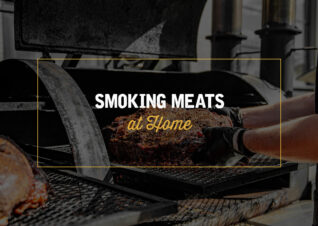

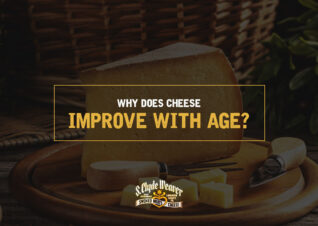
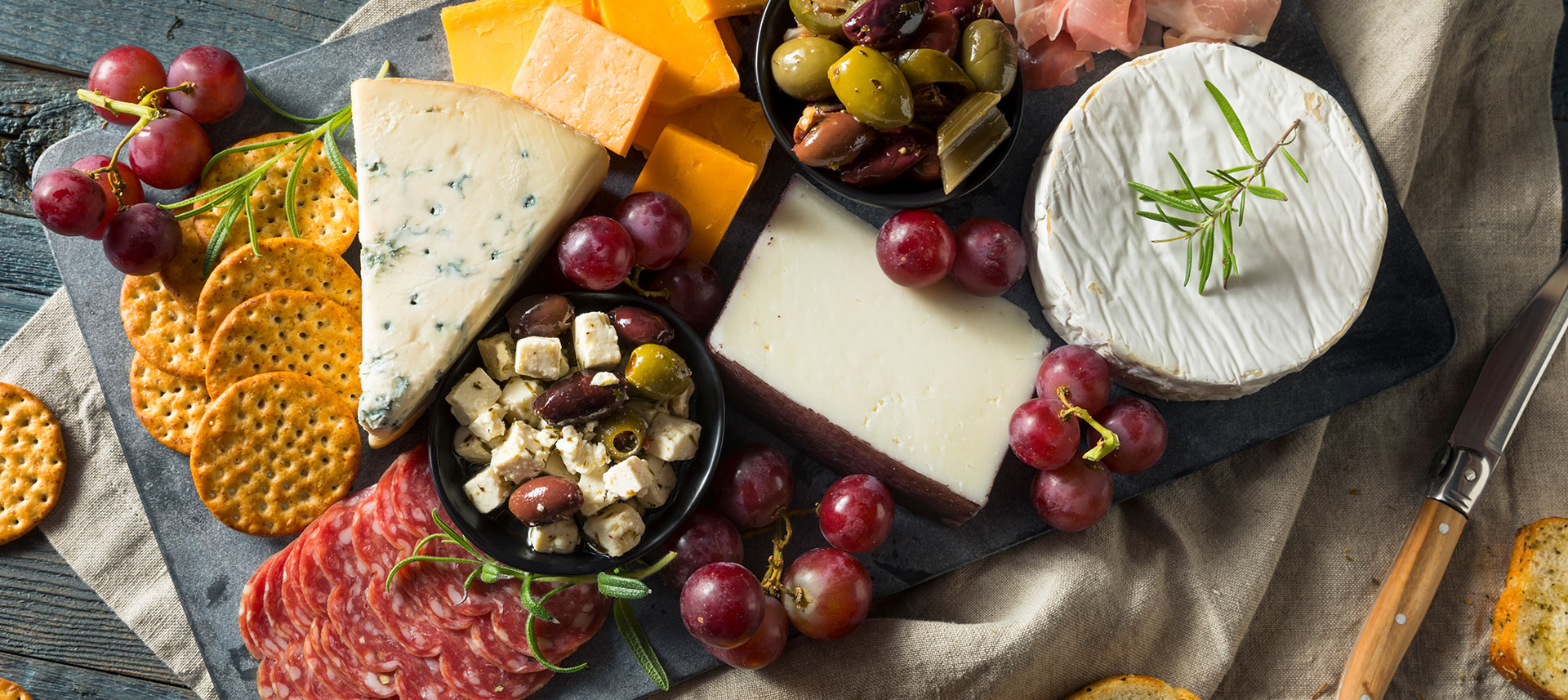
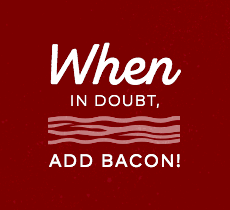
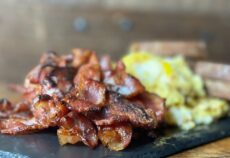
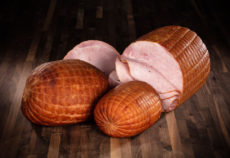

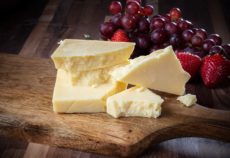
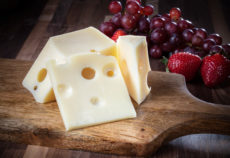
The information was well detailed and useful. Thank you.
I am Satisfied to Review all parts of Primal and Sub primal cuts of the beef. thank u for the information
I am satisfied with the information
review me on primal and sub-primal cut threir tenderness